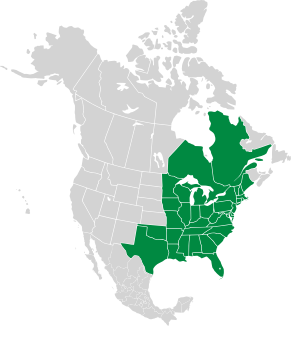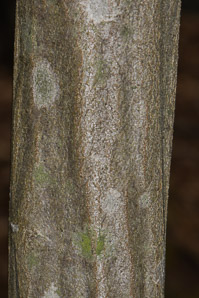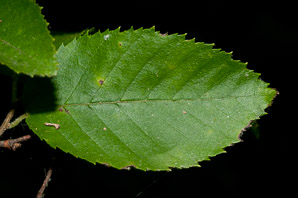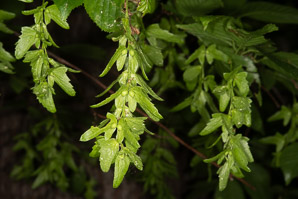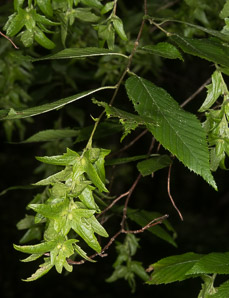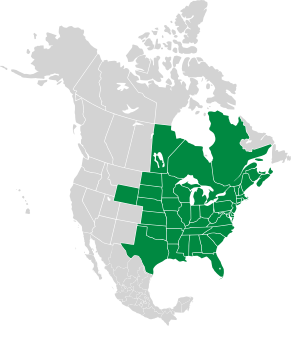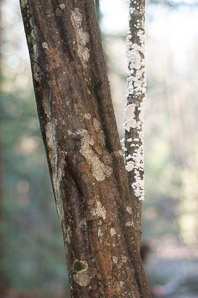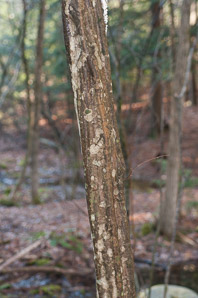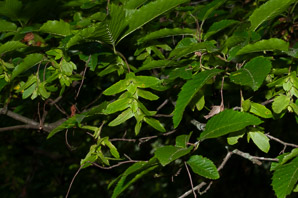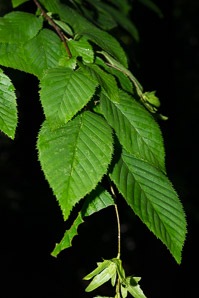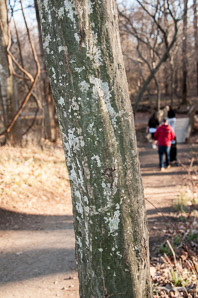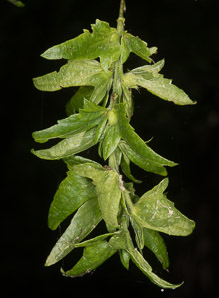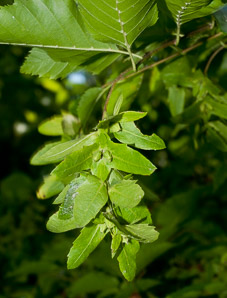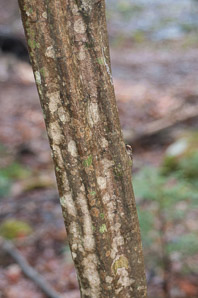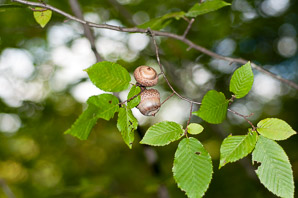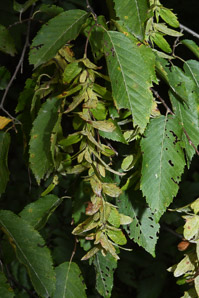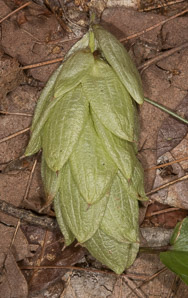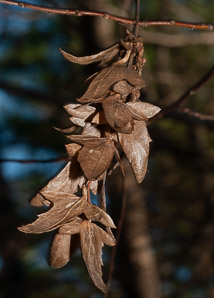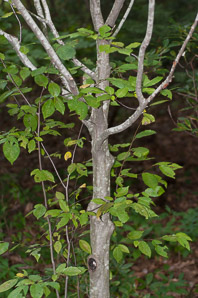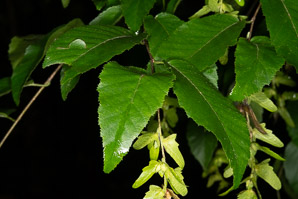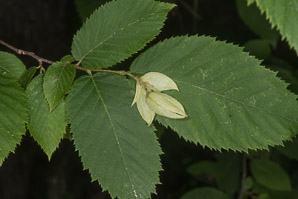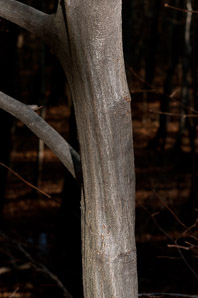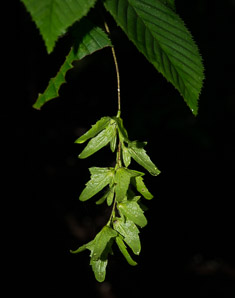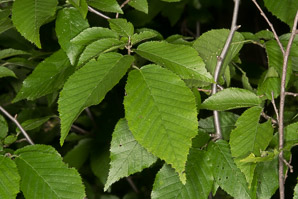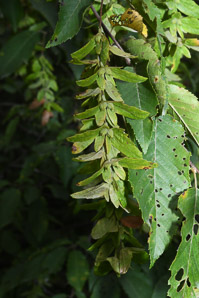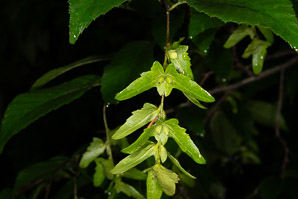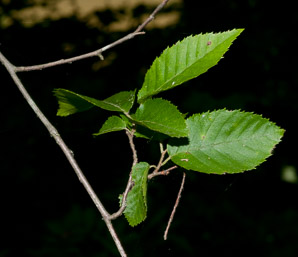
|
Carpinus caroliniana Walter American hornbeam, ironwood, musclewood
American hornbeam is native to eastern North America. Its white, very hard wood was prized for ox yokes and tool handles by American colonists, though the relatively small size of the trees limits its commercial use today. Hornbeam and hophornbeam are unrelated and quite different in appearance: Plants: Trees reach 33-49′ (10-15 m) (rarely 66′ (20 m) in height, and often have multiple stems. Bark is smooth, dark bluish gray, furrowed near the base in older trees. The trunks are often fluted with vertical depressions that look a little like rippling muscles. Leaves: Dark green, alternate, 1-4½″ (3-12 cm) long, with prominent parallel veins and fine serrations or double serrations. Flowers: Female flowers are white; male are green—both occur on the same tree. Fruits: A small ribbed nut ¼-5/16″ (7-8 mm) long, surrounded by a three- to seven-pointed leaf group called an involucre, ¾-1″ (2-3 cm) long. The involucres occur in clusters, and remain on the tree after other leaves drop in the fall. Online References:
The University of Connecticut Plant Database The Virginia Tech Department of Forest Resources and Environmental Conservation The USDA Forest Service's Silvics of North America site The Lady Bird Johnson Wildflower Center Plants for a Future, a resource and information centre for edible and otherwise useful plants |
4/23/2016 · Big Tree/Porcupine Trail, Beaver, Hollis, Massachusetts 6/13/2011 · Great Falls State Park, Washington, DC · ≈ 3½ × 2½″ (9.8 × 6.6 cm) 6/26/2017 · Beaver Brook Conservation Area, Hollis, Massachusetts · ≈ 7 × 4½″ (18 × 12 cm) 6/23/2017 · Nashua River Rail Trail, Groton, Massachusetts · ≈ 5 × 8″ (13 × 20 cm) |
||||||||||||||||||||||||||||
|
| |||||||||||||||||||||||||||||
Ostrya virginiana |
You are here Carpinus caroliniana |
||||||||||||||||||||||||||||
|---|---|---|---|---|---|---|---|---|---|---|---|---|---|---|---|---|---|---|---|---|---|---|---|---|---|---|---|---|---|
| Common Name |  |
 |
|||||||||||||||||||||||||||
| Plant | Small tree, to 20-30′ (6.1-9.1 m). Bark reddish brown to gray brown, in loose strips. | Trees reach 33-49′ (10-15 m), and often have multiple stems. Bark is smooth, dark bluish gray, furrowed near the base in older trees. The trunks are often fluted with vertical depressions that look a little like rippling muscles. | |||||||||||||||||||||||||||
| Flowers | Male catkins are ¾-1¾″ (2-5 cm) long; female catkins are ¼-½″ (8-15 mm) long | Female flowers are white; male are green—both occur on the same tree. | |||||||||||||||||||||||||||
| Leaves | Unlobed, alternating, 1¾-5″ (5-13 cm) × 1½-2″ (4-6 cm), with double serrations on the edges. Tops are yellow-green, bottoms are pale green. | Dark green, alternate, 1-4½″ (3-12 cm) long, with prominent parallel veins and fine serrations or double serrations. | |||||||||||||||||||||||||||
| Fruit | Brown nuts 1/16-3/16″ (3-5 mm) long, in conelike drooping clusters enclosed in white papery sacs. | A small ribbed nut ¼-5/16″ (7-8 mm) long, surrounded by a three- to seven-pointed leaf group called an involucre, ¾-1″ (2-3 cm) long. The involucres occur in clusters, and remain on the tree after other leaves drop. | |||||||||||||||||||||||||||
| Range/ Zones |
|
|
|||||||||||||||||||||||||||
| Habitats | River banks, swamp edges, flood plains, in fertile soil, both moist and dry | Rich wet soils such as floodplains, swamps, or mucks | |||||||||||||||||||||||||||
| Type | Wild | Wild | |||||||||||||||||||||||||||
1/1/2012 · Big Tree Trail • Tudor Richards Natural History and Forest Trail, Hollis, New Hampshire · ≈ 12 × 17″ (29 × 44 cm) 
1/1/2012 · Big Tree Trail • Tudor Richards Natural History and Forest Trail, Hollis, New Hampshire 
6/13/2011 · Great Falls State Park, Washington, DC · ≈ 11 × 7″ (27 × 18 cm) 
7/24/2013 · Beaver Brook Assn Conservation Lands, Rte. 130, Hollis, New Hampshire · ≈ 7 × 10″ (16 × 25 cm) 
11/30/2014 · James River, Midlothian, Virginia · ≈ 1½ × 2′ (47 × 71 cm) 
6/23/2017 · Nashua River Rail Trail, Groton, Massachusetts · ≈ 6 × 4″ (15 × 10 cm) 
6/13/2011 · Great Falls State Park, Washington, DC · ≈ 4½ × 7″ (11 × 17 cm) 
1/1/2012 · Big Tree Trail • Tudor Richards Natural History and Forest Trail, Hollis, New Hampshire · ≈ 12 × 17″ (29 × 44 cm) 
6/28/2017 · Andres Art Institute, Big Bear Mountain, Brookline, New Hampshire · ≈ 4½ × 7″ (12 × 18 cm) 
Hornbeams don’t have acorns!!! Looks like the acorns fell from another tree. · 9/14/2010 · Garden in the Woods, Framingham, Massachusetts · ≈ 12 × 8″ (31 × 20 cm) 
7/27/2016 · State Arboretum of Virginia, Boyce, Virginia 
Carpinus caroliniana description by Thomas H. Kent, last updated 5 Sep 2023.
© FloraFinder.org. All rights reserved.
7/30/2017 · Jason’s Cutoff and Nearby Trails, Beaver Brook Conservation Area, Hollis, New Hampshire · ≈ 4½ × 7″ (12 × 18 cm) ![]() ID is uncertain
ID is uncertain 
11/30/2011 · Nashua River Rail Trail, Groton · ≈ 3½ × 5″ (9.2 × 13 cm) 
9/14/2010 · Garden in the Woods, Framingham, Massachusetts 
6/10/2018 · ≈ 6 × 4″ (16 × 11 cm) 
6/28/2017 · Andres Art Institute, Big Bear Mountain, Brookline, New Hampshire · ≈ 6 × 4″ (16 × 11 cm) 
11/30/2011 · Nashua River Rail Trail, Groton · ≈ 7 × 11″ (18 × 27 cm) 
7/24/2013 · Beaver Brook Assn Conservation Lands, Rte. 130, Hollis, New Hampshire · ≈ 7 × 10″ (16 × 25 cm) 
6/22/2017 · Garden in the Woods, Framingham, Massachusetts · ≈ 8 × 5″ (20 × 13 cm) 
7/27/2016 · State Arboretum of Virginia, Boyce, Virginia 
6/10/2018 · ≈ 6 × 4″ (16 × 11 cm) 
6/13/2011 · Great Falls State Park, Washington, DC · ≈ 7 × 4½″ (17 × 11 cm) 
Range: Zones 3-9:
